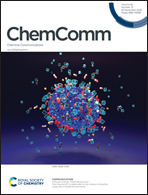Controlling the quantity of γ-Fe inside multiwall carbon nano-onions: the key role of sulfur†
Abstract
One of the most interesting structural features of multiwall carbon onions (MWCNOs) and nanotubes (MWCNTs) is the excellent chemical stability, which allows in situ encapsulation of chosen magnetic materials of interest and multifunctional applications. In this letter, we present an innovative chemical vapour synthesis (CVS) approach, in which the inclusion of small quantities of sulfur during the pyrolysis of ferrocene/dichlorobenzene mixtures allows for an important control in the relative abundance of FCC γ-Fe, up to a maximum value of ∼86.5% (structural- and phase-control). The variation in the relative percentage of the encapsulated Fe-based phases was estimated by employing X-ray diffraction (XRD) and Rietveld refinement analyses. The magnetic characterization was achieved by employing superconducting quantum interference device (SQUID) magnetometry, with zero field cooled (ZFC) and field cooled (FC) curves acquired at applied fields of 300 Oe and ∼50 000 Oe.



 Please wait while we load your content...
Please wait while we load your content...